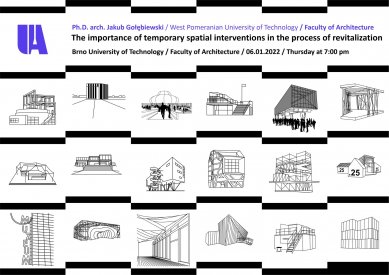
Jakub I. Gołębiewski: The importance of temporary spatial interventions in the process of revitalization
Pořadatel
FA VUT Brno
Místo konání
Microsoft Teams
Start
thu 06.1.2022 19:00
Odkaz
www.facebook.com ...
FA VUT Brno
Místo konání
Microsoft Teams
Start
thu 06.1.2022 19:00
Odkaz
www.facebook.com ...
Lectures
Czech Republic
Brno
Publisher
Tisková zpráva
Tisková zpráva
Jakub Ignacy Gołębiewski, Ph.D. Civil engineer architect graduated in 2009 from the Faculty of Architecture and Urban Design at the West Pomeranian University of Technology in Szczecin. Currently, he is an assistant professor in the Department of History and Theory of Architecture at the Faculty of Civil Engineering and Architecture, the West Pomeranian University of Technology in Szczecin. In his scientific activity, he deals with the revitalization of post-industrial spaces and waterfronts; heritage protection, art in public space, and temporary architecture. He is the author of many scientific articles in Polish and foreign publications and a speaker at scientific conferences. As a tutor, he participated in many national and international architectural and urban workshops.
In architectural practice, he is the co-author of many architectural concepts, completed projects, and competition concepts that received awards. From 2010 to 2019, he has been cooperating with the Izomorfis Architectural Studio, where he participated in numerous projects, including residential buildings, public facilities, and adaptive reuse of historic buildings. Since 2017, he has been running the Skala Architectural Studio together with Romea Muryń. He is a member of the Chamber of Architects of the Republic of Poland and a member of the Association of Polish Architects.
The importance of temporary spatial interventions in the process of revitalization
Increasing social activity of city residents is manifested in the growing interest in common spaces. More and more frequently the border between passive commenting on reality and an active desire to change is exceeded. The artists, social activists, and entrepreneurs initiate the process of space revitalization in a bottom-up way. As a result of these actions, degraded parts of the cities receive a new life. Despite the temporary nature of these interventions, they can be a prelude to more permanent transformation. Temporary spatial interventions make a positive contribution in the course and dynamics of revitalization processes by stimulating social and culture-forming activities in a degraded or abandoned urbanized environment.
During the author's research on examples of temporary spatial interventions in revitalization processes, three strategies have been defined that may be applicable in various urban areas. The first one shows the possibilities of revitalization of broad city areas by concentration of temporary spatial interventions within them. The second strategy refers to the issue of time-consuming nature of revitalization processes and investment execution, pointing to the examples of temporary objects which are a preview of target function in the city space. The third strategy aims at taming degraded spaces by introducing a temporary culture-creating function. During the lecture, the above strategies will be presented on the example of their use in the process of revitalization of the post-industrial Międzyodrze area in Szczecin.
Microsoft Teams link >
In architectural practice, he is the co-author of many architectural concepts, completed projects, and competition concepts that received awards. From 2010 to 2019, he has been cooperating with the Izomorfis Architectural Studio, where he participated in numerous projects, including residential buildings, public facilities, and adaptive reuse of historic buildings. Since 2017, he has been running the Skala Architectural Studio together with Romea Muryń. He is a member of the Chamber of Architects of the Republic of Poland and a member of the Association of Polish Architects.
The importance of temporary spatial interventions in the process of revitalization
Increasing social activity of city residents is manifested in the growing interest in common spaces. More and more frequently the border between passive commenting on reality and an active desire to change is exceeded. The artists, social activists, and entrepreneurs initiate the process of space revitalization in a bottom-up way. As a result of these actions, degraded parts of the cities receive a new life. Despite the temporary nature of these interventions, they can be a prelude to more permanent transformation. Temporary spatial interventions make a positive contribution in the course and dynamics of revitalization processes by stimulating social and culture-forming activities in a degraded or abandoned urbanized environment.
During the author's research on examples of temporary spatial interventions in revitalization processes, three strategies have been defined that may be applicable in various urban areas. The first one shows the possibilities of revitalization of broad city areas by concentration of temporary spatial interventions within them. The second strategy refers to the issue of time-consuming nature of revitalization processes and investment execution, pointing to the examples of temporary objects which are a preview of target function in the city space. The third strategy aims at taming degraded spaces by introducing a temporary culture-creating function. During the lecture, the above strategies will be presented on the example of their use in the process of revitalization of the post-industrial Międzyodrze area in Szczecin.
Microsoft Teams link >
The English translation is powered by AI tool. Switch to Czech to view the original text source.

0 comments
add comment









